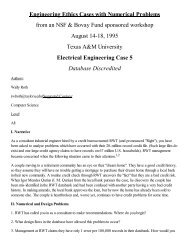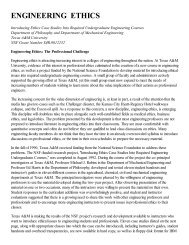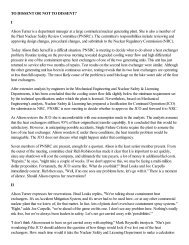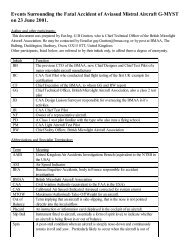Control Design - Engineering Ethics - Texas A&M University
Control Design - Engineering Ethics - Texas A&M University
Control Design - Engineering Ethics - Texas A&M University
You also want an ePaper? Increase the reach of your titles
YUMPU automatically turns print PDFs into web optimized ePapers that Google loves.
<strong>Engineering</strong> <strong>Ethics</strong> Cases with Numerical Problems<br />
from an NSF & Bovay Fund sponsored workshop<br />
August 14-18, 1995<br />
<strong>Texas</strong> A&M <strong>University</strong><br />
Electrical <strong>Engineering</strong> Case 3<br />
<strong>Control</strong> <strong>Design</strong><br />
Authors:<br />
Ottis Barron<br />
Suggested Courses:<br />
<strong>Control</strong> <strong>Design</strong><br />
Level:<br />
Junior<br />
I. Narrative<br />
Your company is designing a new compress to be used in baling scrap fabric. The baling process requires that<br />
the machine be cleaned of lint between every use to avoid mixing material colors. The compress is to have four<br />
ram positions: a) the up position allows the scrap to be loaded; b) the retract position allows the bale to be<br />
removed; c) the press position holds the scrap in the compressed state for strapping; and d) the down position<br />
allows access to the upper part of the compress for cleaning.<br />
Four pushbuttons (PB) are to be used to control the motion of the ram and four sensors are to be used to<br />
indicate the ram position. A 220 volt ac motor is to be used to power the hydraulic pump for driving the<br />
hydraulic cylinder which positions the ram. A 2-position 110 volt solenoid will operate a valve to determine the<br />
direction of ram movement when the pump is running.
II. <strong>Engineering</strong> Questions<br />
1.<br />
<strong>Design</strong> a logic circuit for controlling the valve position and the power to the motor . Prepare a parts list and cost<br />
estimate for your design. Be prepared to present and defend your design at the next class meeting.<br />
Questions: a) Did you make use of "don't care" states to simplify your design?<br />
b) If your answer to 1) is "yes", what happens to the system operation if the impossible "don't care" conditions<br />
do in fact occur?<br />
c) Are there safety considerations which should be included in your design?<br />
2. (For use in in-class discussion) Several years after compress production has begun, you are examining the<br />
schematic of the control circuit when you notice a potential problem. Pump power will be applied when the<br />
retract PB is pushed with the ram in the down position. This of course is the desired action for moving the ram up<br />
to the retract position where the pump power is removed. However, if the down sensor is again activated, pump<br />
power is again applied and the ram will move upward. Under what conditions might this present a problem?<br />
3. Prepare a short written presentation for your group leader which presents your analysis of the seriousness of<br />
the problem. Also be prepared to present your analysis in the weekly staff meeting.<br />
Further class discussion may include:<br />
a) What is your responsibility to examine the system response to "don't care" states?<br />
b) How much consideration should you give to the possibility of operator error (or stupidity)?
c) Under what conditions should you attempt to "idiot proof" your design?)<br />
4. Suppose the ram is placed in the retract position and left there for an extended time. As the hydraulic pressure<br />
in the cylinder gradually bleeds down, the ram slowly lowers. As the ram continues to drop, the down sensor is<br />
eventually activated and the ram retracts. If the operator happens to be cleaning the machine at the time, a<br />
serious injury is likely to occur. What recommendations would you make to your manager to guard against this<br />
unlikely event`?<br />
5. What can you include in your design to protect the operator in a potentially dangerous situation? (Interlocks,<br />
warning labels, operating proceedures, instruction manuals, etc. How likely is it that the operator may be<br />
poorly educated, maybe illiterate? Should this be a design consideration?)<br />
III. Ethical Questions<br />
1. In view of the fact that no problems have been reported with the 10,000 machines presently in operation,<br />
management holds that no action is needed with respect to the problem. What is your response? Would your<br />
response change if production included only 500 machines? 500,000?<br />
2. Suppose that the machine is scheduled to go into production next Monday. Incorporation of safety interlocks<br />
to prevent the motor running when the access gate is open would cost only $2.00 per unit but would result in an<br />
8 week delay in production. This delay would seriously impact the company market position because a<br />
competitor is expected to have a comparable machine available in 4 weeks. Would you recommend<br />
incorporation of the safety interlocks? Be prepared to defend your position.<br />
IV. <strong>Engineering</strong> Solutions<br />
There are a number of safety features that should be considered. These include:<br />
a) panel lights to alert the operator to the operational status of the machine,<br />
b) interlocks to prevent pump operation when the access gate is open,<br />
c) location of control panel so that it is visible from the gate area of the machine,<br />
d) others.<br />
There are several solutions to the design problem, some better than others. One possible solution is presented<br />
here.<br />
The four push-buttons (PBU for up, PBR for retract, PBP for press, and PBD for down) are used to individually<br />
set four latches (LU, LR, LP, and LD). The four position sensors (U, R, P, and D) provide two outputs; one<br />
indicates that the ram is in position (indicated by 1), the other that it is not (indicated by 0). Panel lights are turned<br />
on by the 0 output of the latch and indicate the last activated push-button (and therefore the ram position if the<br />
motor is not running).<br />
Assumptions include: 1) only one PB at a time is activated,
2) once a PB is activated, the motor runs until the desired position is reached.<br />
Logic equations are:<br />
Vd = U1 * (LD1 + LP1 + LR1) + R1 * (LD1 + LP1) + (P1 * LD1)<br />
Vu = D1 * (LP1 + LR1 + LU1) + P1 * (LR1 + LU1) + (R1 * LU1)<br />
M = (LU1 * and0) + (LR1 * R0) + (LP1 * P0) + (LD1 * D0)<br />
Vd activates the down direction solenoid, Vu activates the up direction solenoid, and M activates the motor<br />
power circuit.
V. Solutions to Ethical Questions<br />
1. According to the code of the Institute of Electrical and Electronics Engineers (IEEE), members of the IEEE<br />
are obligated to "accept responsibility in making engineering decisions consistant with the safety, health, and<br />
welfare of the public, and to disclose promptly factors that might endanger the public or the environment." This<br />
requirement applies whether 500 or 500,000 machines are sold. Given the safety problems with the machine, the<br />
danger should be disclosed. The The dangers may only rarely appear. This is a factor in determinging how far<br />
one should go in trying to secure design changes. The expense involved in the changes should also be<br />
considered.<br />
2. Safety interlocks are inexpensive, and they could be featured prominently in advertising. They might also<br />
prevent expensive lawsuits. The delay might be costly in the short run, but pay off in the long run. Besides, it<br />
would definitely promote safety. Management might even be able to get customers to accept the delay,<br />
considering that the machine will be safer than the competition's product.<br />
There are several models of professional responsibility. One model (the Malpractice Model) advocates only<br />
avoiding directly causing harm. The Due-Care Model promotes attempts to prevent problems, not simply not<br />
cause them. The second model clearly justifies making the safety changes. Which model do you think is more in<br />
accord with engineering professionalism?













